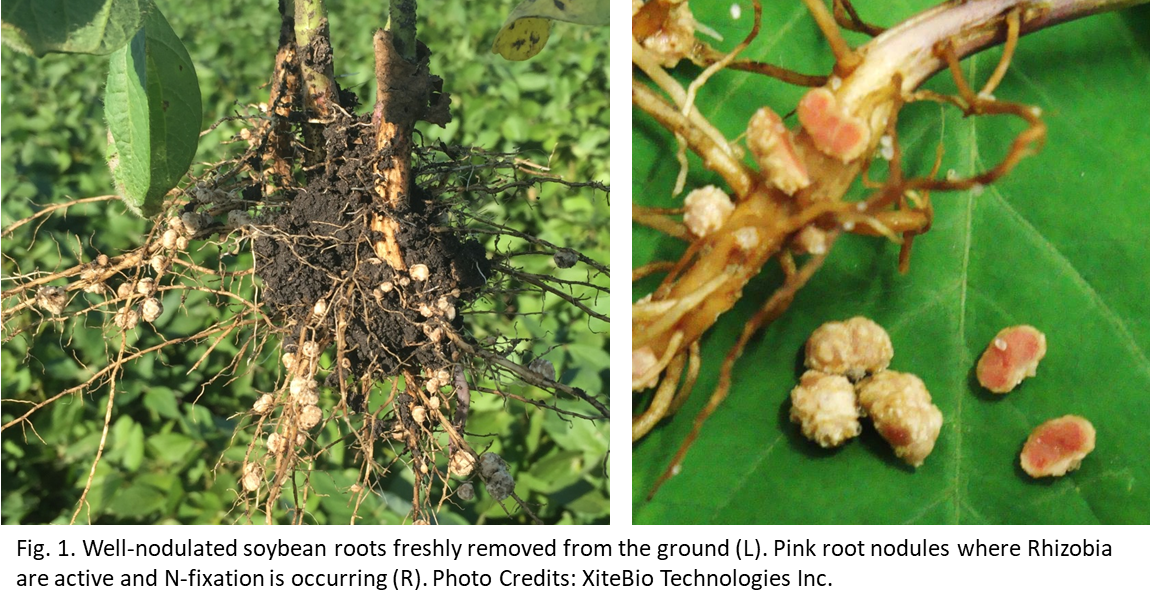Nitrogen (N) fertilizer management is important for the success of any crop. It is an expensive input, with this season‘s prices especially high. The price of all major N fertilizers are up between 7-11% compared to this time last year, so growers are looking for the best way to reduce application costs while still increasing yields now more than ever (1). One group of popular row crops has a way around heavy N inputs. Legume crops are able to get their own N through root nodules containing N-fixing bacteria, which supply the plant with N pulled right from the air. But root nodules do more than just provide N to the host plant, they can put some of that N back into the field as well. In this week’s edition of Growing Possibilities, we will be looking at root nodules: what they are and how they help not only your crop, but your field itself.
A high yielding crop requires a large amount of N, and legumes have some of the highest N requirements in row crops. For example, a 35 bu/ac soybean crop will uptake 160-200 lbs/ac of N from the soil and a 50 bu/ac pea crop will uptake 138-168 lbs/ac of N (2). Legumes have evolved a clever way of getting this high N requirement naturally: the use of N-fixing bacteria. When specific soil bacteria (called rhizobia) come into contact with a root hair of a legume, it can colonize the root and form a symbiotic structure called a nodule. Within these nodules, the rhizobia take N from air within the soil and supply it directly to the plant. In return, the plant provides food for the bacteria, creating a mutual or symbiotic relationship between them. In certain soils, these bacteria that are specific to each crop, often do not exist naturally or sometimes not in adequate number and must be added in the form of bacterial inoculants, something all legume farmers are generally familiar with.
The amount of N fixed by a successfully nodulated crop is substantial. Soybeans can get up to 60% of their required N through N-fixation, while Peas, Lentils and Faba beans can get up to 80% (3). The amount of N these crops can get through this process depends on the population of healthy rhizobia in the soil. A large population of fresh, active bacteria that are in an optimal state to nodulate your crop roots are required to have the best results. To ensure this population exists, it is usually recommended to apply a rhizobial inoculant every year during seeding.
The substantial N-fixation of a legume crop not only benefits the crop itself, but also the field it is grown in. A portion of the N fixed by legume crops will be left behind in the soil during the decay and breakdown of leftover plant matter after harvest. For example, a dense soybean crop that has optimal nodulation/N-fixation can add 30-50 lbs/ac of N back into the soil (4). This is one of the reasons why adding a legume crop to your crop rotation is recommended as a way to generate soil fertility benefits for future crops.
So how do you know if your inoculant is working? How do you know that nodules have formed and are fixing N?
Checking your plants for effective nodulation is a straight forward process:
- Wait 4-6 weeks after planting. It takes this long for nodules to form and N fixation to begin.
- Carefully dig out a plant with the roots and surrounding soil still intact. Gently wash or break away the soil for the roots to reveal the nodules (Fig. 1).
- Slice a root nodule in half and check the color of the interior. If the inside is pink, then N fixation is taking place (Fig. 1). If your nodules are green/grey on the inside, this means they are inactive or not fixing N. Young nodules that are still developing will have a white/grey color, and may just need more time before they begin N fixation.
A well nodulated legume crop has a multitude of benefits, and not just on your yield monitors. Using a rhizobial inoculant, either on-seed or in-furrow, can provide benefits and efficiency that chemical crop inputs are hard-pressed to match. Visit xitebio.ca to learn how our premium liquid inoculants (XiteBio PulseRhizo or XiteBio SoyRhizo) can help your pulse or soybean crops reach their highest potential this season.
References:
1) https://www.dtnpf.com/agriculture/web/ag/crops/article/2021/03/03/fertilizer-prices-upward-momentum
2) Canadian Fertilizer Institute


